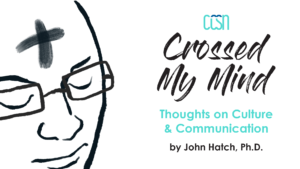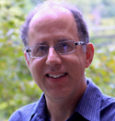 Column title: Crossed My Mind: Thoughts on Culture and Communication
Column title: Crossed My Mind: Thoughts on Culture and Communication
Column entry: “Untangling CRT for Christians (Part 2 of 4)”
By John Hatch, Ph.D.
Eastern University (retired)
CCSN Senior Fellow
Column Description: As Christians, we are called to have the mind of Christ. This goes against the grain of our social and cultural conditioning. We seek personal or political advancement; Christ seeks the lost and the least. We grasp for cultural ascendency; Christ descends to the cross of love. This column is dedicated to thinking about culture and communication under the sign of the cross.
March 2025 / February 2025 / September 2024 / August 2024 / June-July 2024 / May 2024 / April 2024 / March 2024 | February 2024(2) / February 2024(1) / January 2024 / December 2023 / November 2023 / October 2023 / July 2023 / June 2023 / May 2023 / April 2023 / March 2023 / February 2023 / January 2023 / December 2022 / November(2) 2022 / November 2022 / October 2022 / August-September 2022 / June-July 2022 / January 2022 / December 2021 / October-November 2021
March 2025
Untangling CRT for Christians (Part 2 of 4)
In Part 1 of this series, I introduced Ed Uszynski’s Untangling Critical Race Theory (InterVarsity Press, 2024) as the book I wished had been around five years ago: a primer, a balanced evaluation, and a wise guide for Christians responding to CRT. I unpacked Uszynski’s personal and professional qualifications to write on this subject (for conservative evangelicals in particular), and I summarized his overviews of Marxism and Critical Theory, from which CRT sprang. Although I originally planned to write two columns on Untangling Critical Race Theory, I now realize that it will take four to do it justice. A year ago, I did a four-part series on Voddie Baucham’s highly problematic treatment of CRT, Fault Lines. Uszynski’s far sounder treatment deserves at least as much attention. In this second installment, I’ll unpack his overview of Critical Race Theory, what it gets right about race, how it gets misapplied, and how some Christians fail to put it in appropriate perspective.
As Uszynski explains in chapter 5, the seeds of CRT were sown when law scholar Derrick Bell realized in the 1970s that his successes with school desegregation court cases were largely being nullified by various forms of retrenchment from white-dominated organizations and political movements. Bell began to wonder if racism was baked into the mindsets and structures of society, regardless of legal changes. His pioneering work on this idea, together with that of his Harvard protégé, Kimberle Crenshaw, culminated in a 1989 gathering of scholars at the University of Wisconsin in Madison to discuss what they called “new developments in Critical Race Theory.”[i]
Although CRT has developed into diverse streams of thought over the last four decades, Uszynski identifies a common line of reasoning at its core:
- The racialization of American society put in place across four hundred years didn’t evaporate after the passing of civil rights laws in the 1960s.
- Race-based disparity and inequality live on, unevenly dispersed throughout our social structures, systems, and institutions for many different reasons.
- Law helped create those imbalances and, in some cases, now maintains, supports, and covers them.
- A Critical Race theorist seeks to reveal, confront and reverse how dominant-culture racial power works through laws, policies, and patterns to maintain status quo racial hierarchy in the everyday lives of minority, nonwhite people.[ii]
To clarify these ideas, the author presents a series of statements highlighting the contrast between CRT and commonly held assumptions in the wake of the civil rights movement. For example: “Post-civil rights America says, “Since the civil rights laws were passed, society is set up to provide equal opportunities for everyone who participates responsibly.’ CRT says, ‘Civil rights laws confronted great overt evil, but society maintains racial roadblocks and speed bumps experienced by nonwhite people that create friction no matter how responsible they may be.’”[iii] Or, when conventional wisdom says, “‘Lady Liberty wears a blindfold,’” CRT responds by pointing out how various extralegal pressures—“individual bias, peer pressure, political pressure, financial implications,” etc.—racially skew legal judgment.[iv]
Chapter 6 discusses key tenets of CRT, including the socially constructed nature of race, the ordinariness of racism in America (as a norm embedded deep in our culture), the legitimacy of minority voices and experiences, interest convergence, intersectionality, skepticism toward meritocracy, skepticism about objectivity, and skepticism toward colorblindness and race neutrality. Combining careful explanation with judicious evaluation, Uszynski clarifies four things about each tenet: what it means; what it counters (in society); why it’s important; and how it can be misused. The fourth aspect is especially helpful, as the author recognizes ways in which CRT’s valid points can be (and have been) overgeneralized or misapplied. For instance, while Uszynski affirms that racism is “ordinary”—i.e., that our culture and institutions still commonly manifest racial disparities stemming from a long history of overt racial discrimination—he also recognizes the danger of overreaction: “When you start looking for racism everywhere in response to people who by default never see it anywhere, you start finding it in some places it doesn’t really exist.”[v] Similarly, it’s important to really listen to and recognize the legitimacy of minority perspectives, which were silenced or marginalized for so long; yet this shouldn’t be taken to mean that “‘black is always right and white is always wrong,’” or that “BIPOC people can use their perspective of an experience to excuse wrong behavior.”[vi] Although Uszynski presents caveats like these with due seriousness, he also takes pains to explain the underlying validity of CRT’s tenets and clarify how they differ from these distortions. For instance, CRT recognizes that true objectivity is hard to come by in a world governed by groups’ selfish interests; yet its skepticism toward legal or institutional objectivity “stems not from a post-modern disdain for truth but from a history of intentionally suppressing nonwhite voices.”[vii]
The fact that one can identify in CRT both valid ideas and exaggerations/misapplications of those ideas helps explain why people wearing ideological or political blinders are so divided on the subject. If some place uncritical faith in Critical Theory as the be-all-end-all, others prioritize the conservative politics of culture warfare over truthful representation. Regarding the first error, Uszynski writes: “When CRT concepts become co-opted by people leaning progressively hard left, they are often weaponized and used to slay, especially when packaged with personal anger, pain, and nihilism.” These folks “are better at deconstructing and destroying than building something inclusive and new.”[viii] On the other hand, he sees the converse problem in “radical conservatives, who question anything attempting to disrupt the status quo that maintains the story they tell themselves about themselves.”[ix] CRT’s chief antagonist in this regard is political activist Christopher Rufo, who in 2020 seized upon CRT as a target that he could readily caricaturize, demonize, and use as a rallying cry to oppose any efforts toward raising awareness of persistent racialization in society.[x]
While some have approached CRT with uncritical faith in political conservatism, and others with quasi-religious faith in “capital-P Progressivism,” Uszynski filters it through a biblical faith beholden to no ideology: “Anchored by an understanding of Christian theology, CRT presented itself [to me] as an analytical tool for understanding how the law creates and maintains racial sin, and then it moved beyond the law by asking the same questions of every social institution. I always measured its observations against biblical notions of righteousness and justice. CRT didn’t replace my Christianity—it served it.”[xi] Within this frame, he’s been able to maintain “the difference between using Critical Theory as an empirical method and relying on it as a foundational metanarrative to explain and interpret all aspects of life.”[xii]
When we hold open this space for theological discernment, we can recognize “How Christians Get Race Wrong,” the topic of chapter 8. One way is by hating or slandering others who raise uncomfortable questions or concerns about race in the church. When we’re “discipled by our political climate to see enemies wherever there’s disagreement,” we succumb to un-Christlike posturing: “Caricatures. Assuming the worst. Excusing vengeance in the name of righteous anger. Sticking to a narrative about people even after it’s been shown false.”[xiii] Uszynski discusses how some Christian leaders (such as Voddie Baucham or the panel that created The Statement on Social Justice & the Gospel[xiv]), in their zeal to resist heresy, have misrepresented fellow Christians’ positions on race, creating a straw man. Moreover, an obsession with condemning Critical Race Theory blinds us to a greater threat in mainstream evangelicalism: “uncritical race theory,” a set of assumptions that blind us to persistent walls of racial disparity and hostility in the church stemming from centuries of overt racism, long before CRT came on the scene.
The second half of Untangling Critical Race Theory focuses on helping Christians respond more wisely to race, CRT, and social justice in the church. Parts 3 and 4 of this column series will unpack these ideas.
* The views of any CCSN columnists are their own, and do not necessarily represent the views of the CCSN. We invite and embrace a wide range of views and critiques on important communication and cultural issues from a Christian perspective. The CCSN is a community of Jesus followers who study communication. We do not support or promote a particular social, political, or denominational agenda.
Notes
[i] Uszynski, Untangling Critical Race Theory, 85.
[ii] Quoted from Uszynski, Untangling Critical Race Theory, 88.
[iii] Uszynski, Untangling Critical Race Theory, 90-91.
[iv] Uszynski, Untangling Critical Race Theory, 90.
[v] Uszynski, Untangling Critical Race Theory, 97-98.
[vi] Uszynski, Untangling Critical Race Theory, 100.
[vii] Uszynski, Untangling Critical Race Theory, 104.
[viii] Uszynski, Untangling Critical Race Theory, 116.
[ix] Uszynski, Untangling Critical Race Theory, 116.
[x] See Uszynski, Untangling Critical Race Theory, 118-21.
[xi] Uszynski, Untangling Critical Race Theory, 111-12.
[xii] Uszynski, Untangling Critical Race Theory, 114.
[xiii] Uszynski, Untangling Critical Race Theory, 128-29.
[xiv] In pp. 132-35, Uszynski presents some context regarding these men’s agenda and how it misrepresents the perspectives of fellow Christians who are trying to address real racial disparities in the Church in light of the gospel.

